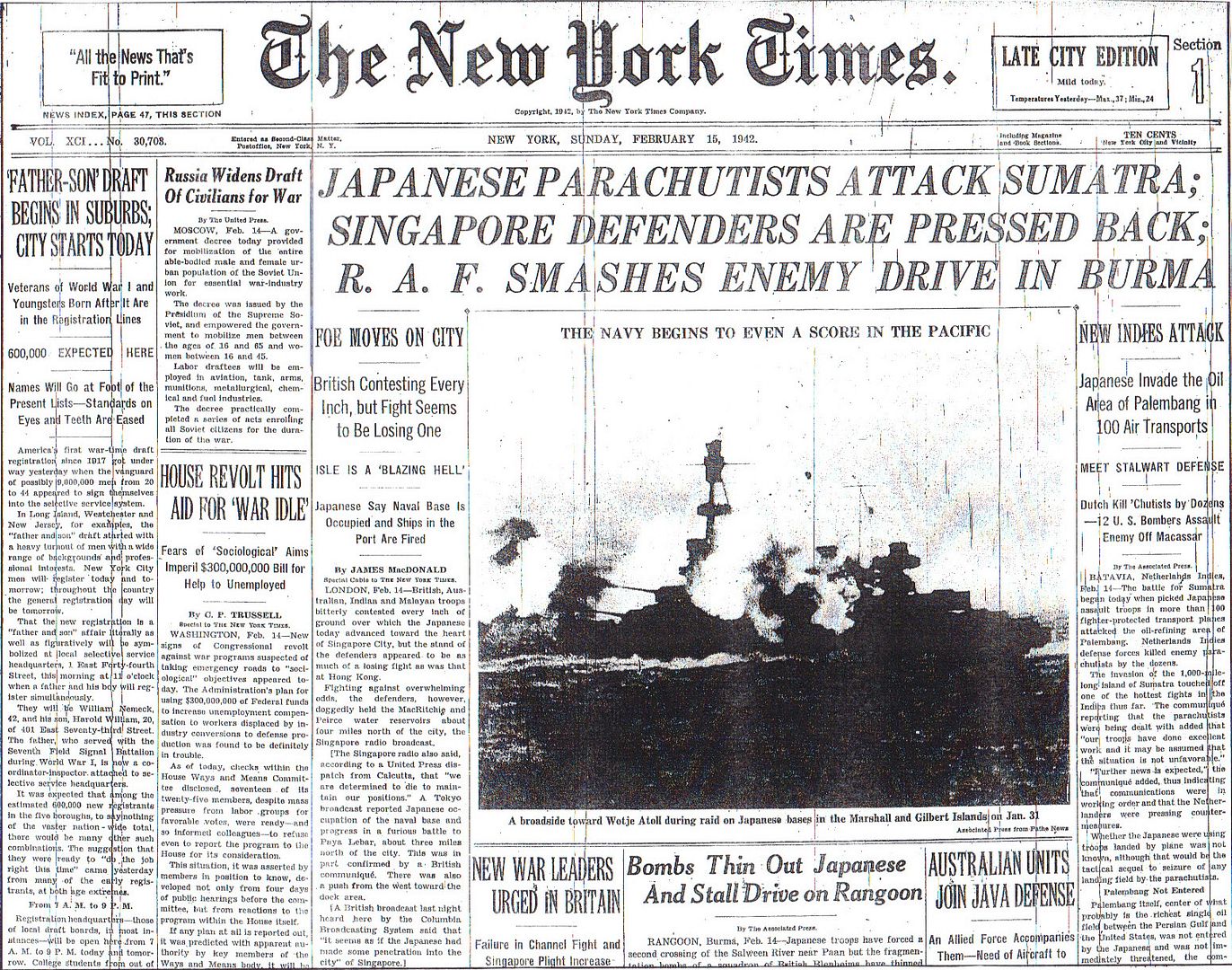
Posted on 02/15/2012 4:38:42 AM PST by Homer_J_Simpson


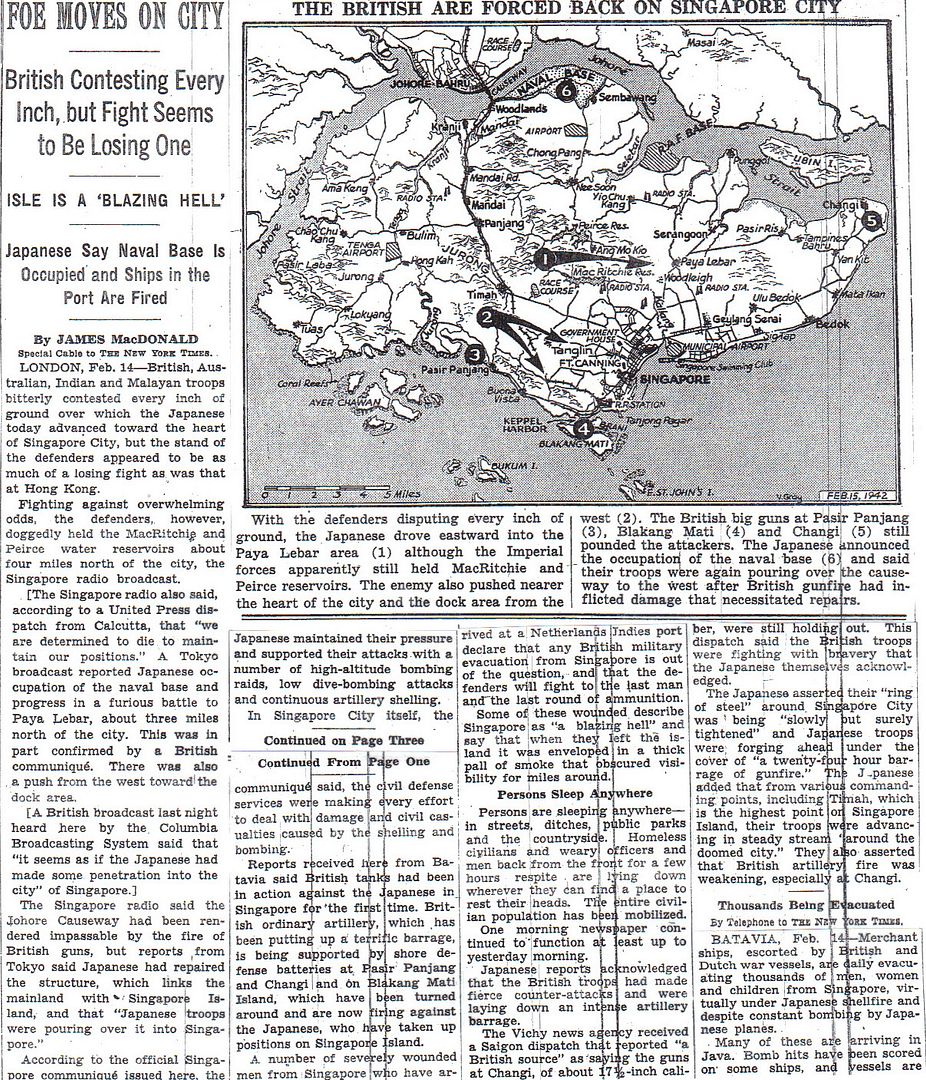
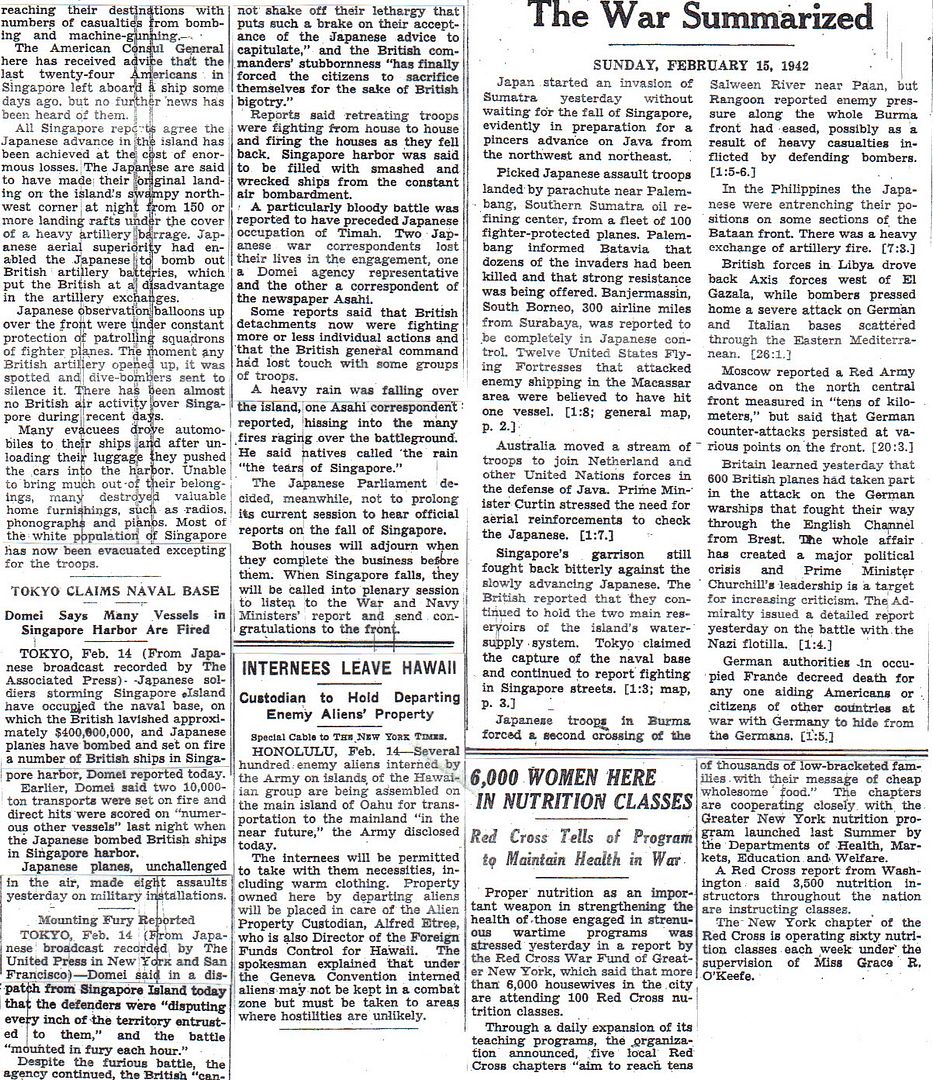
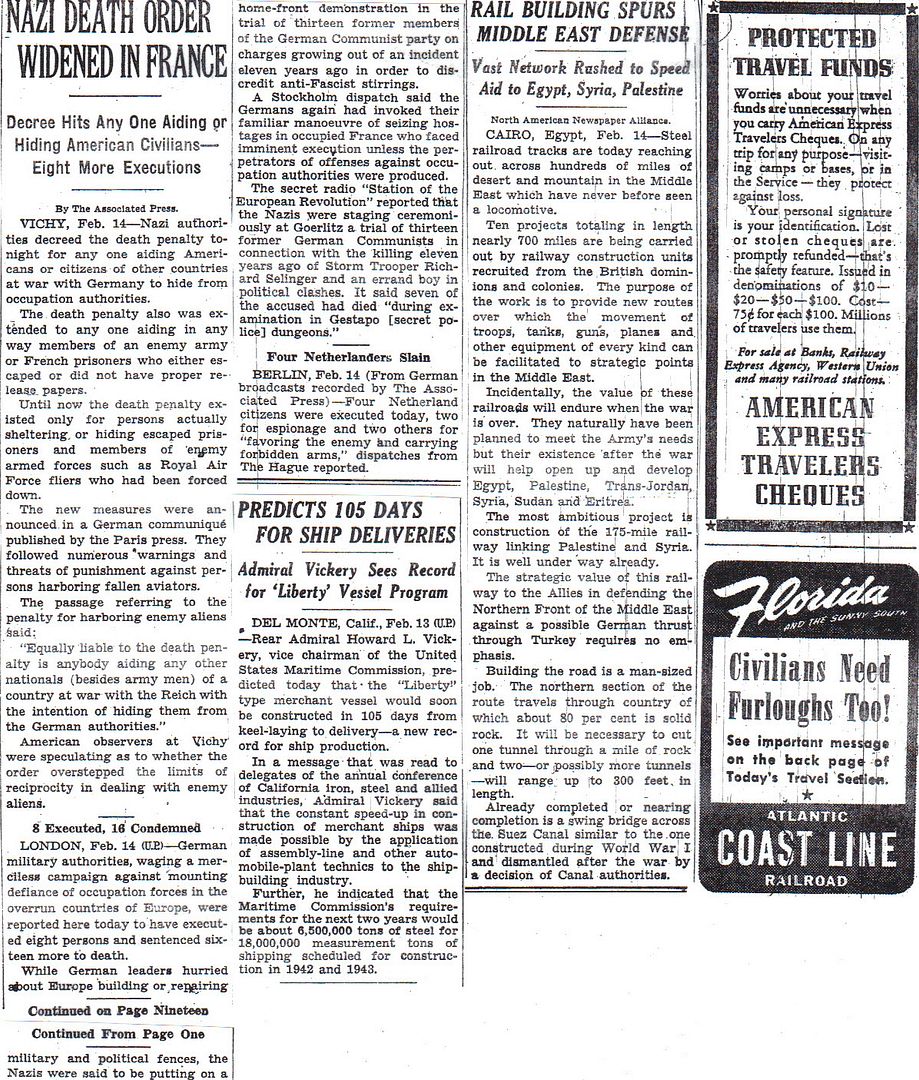
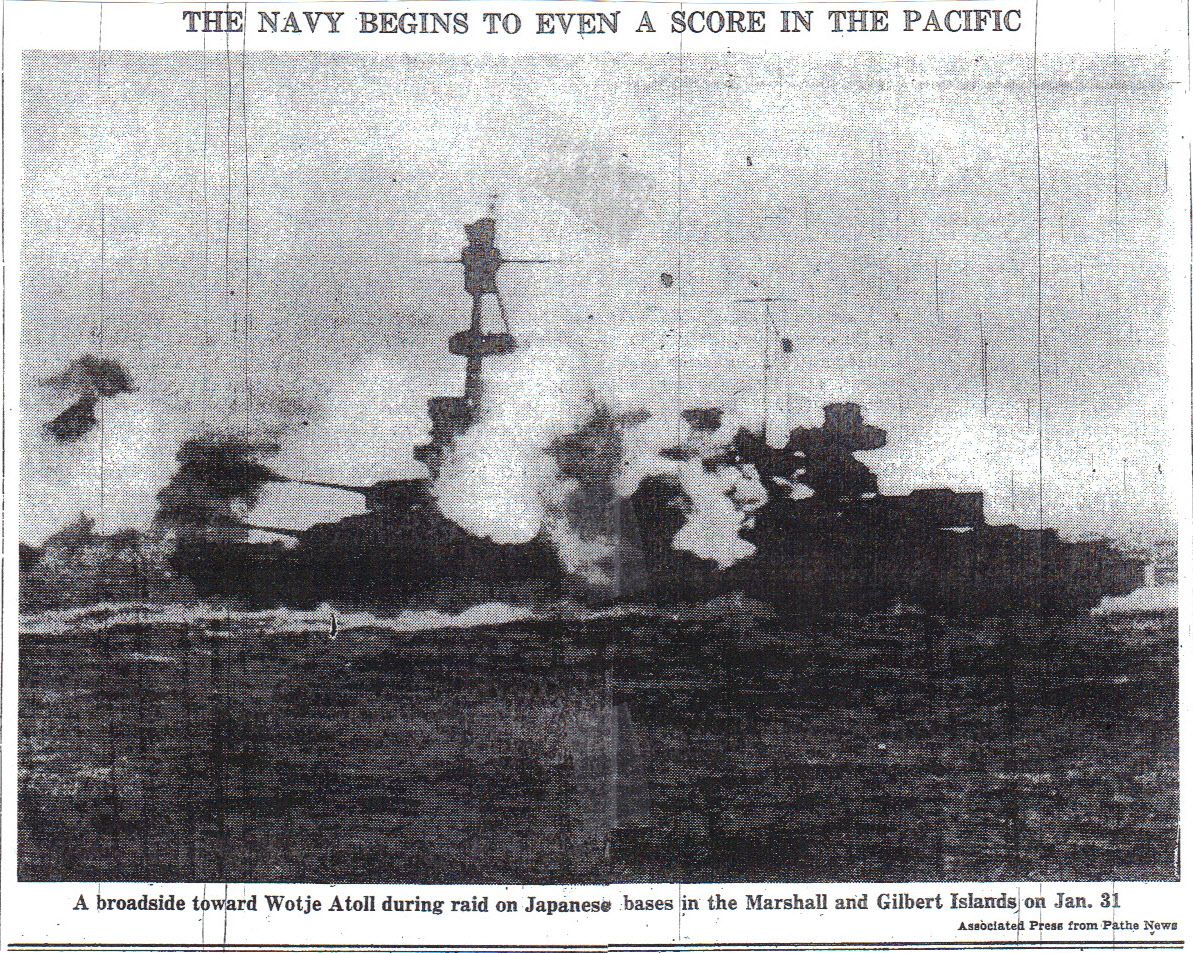
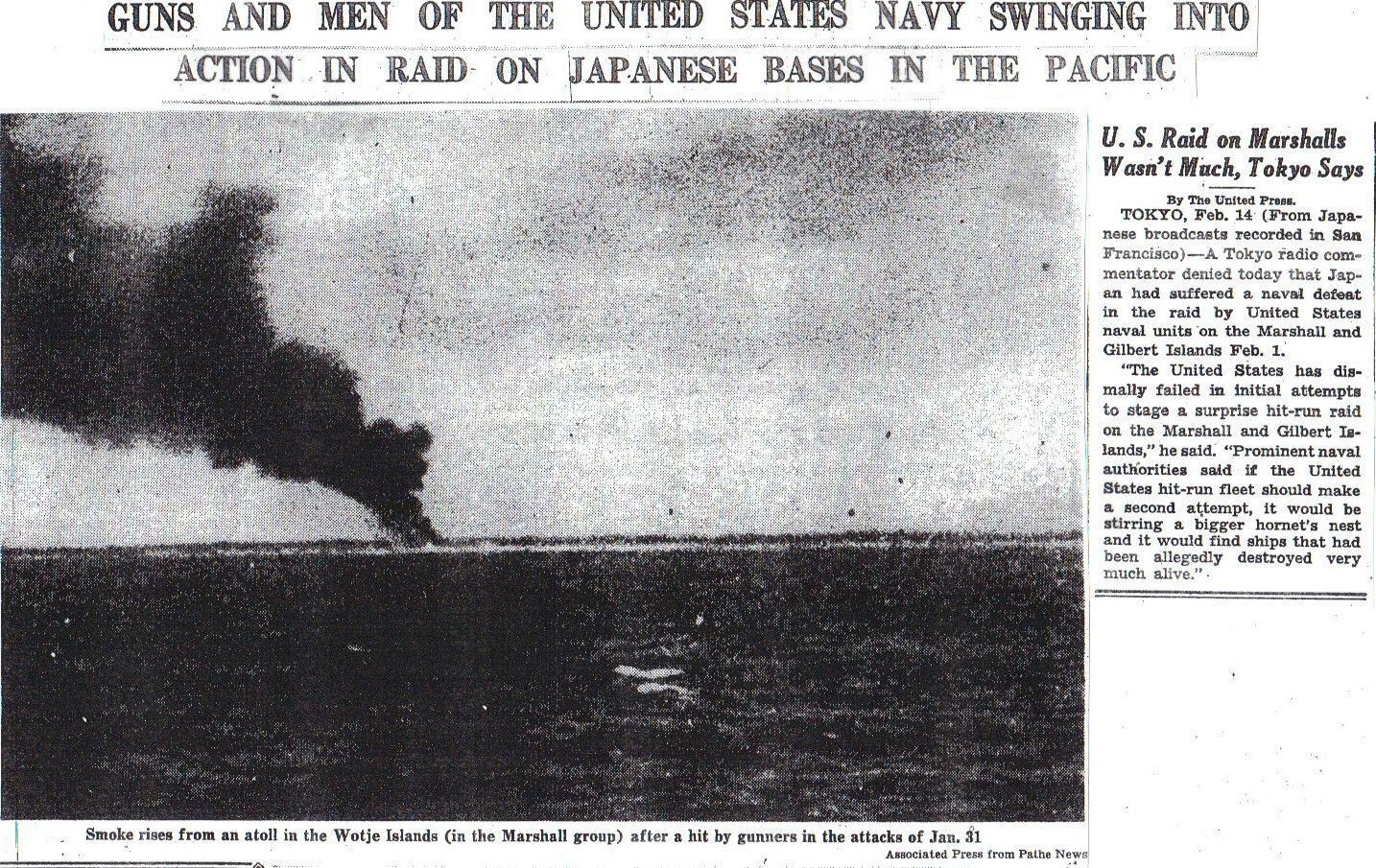



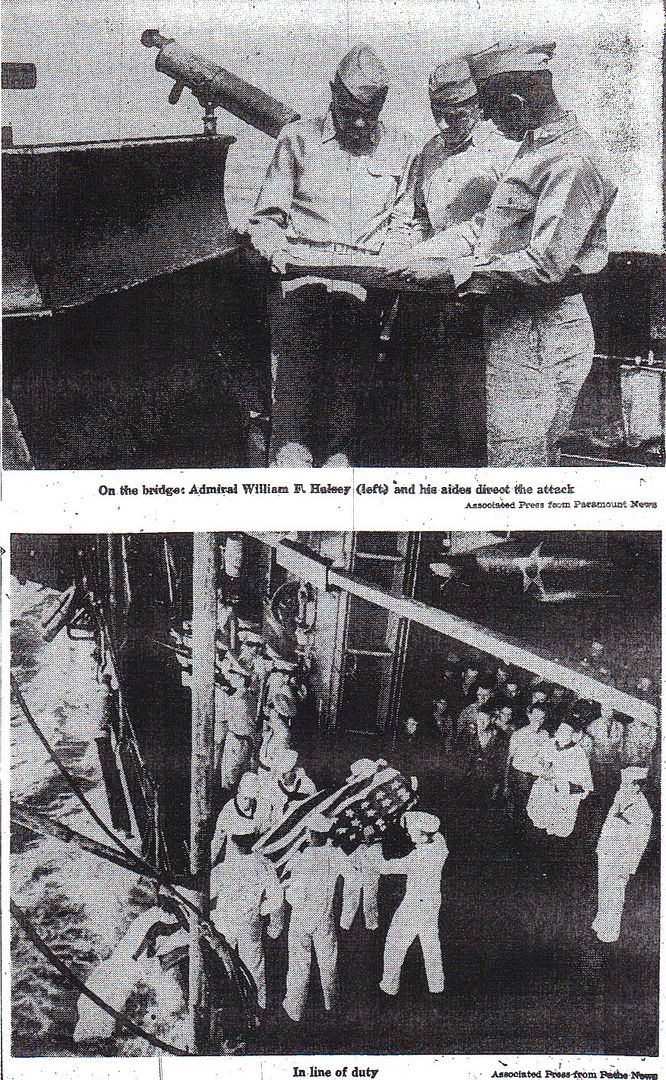
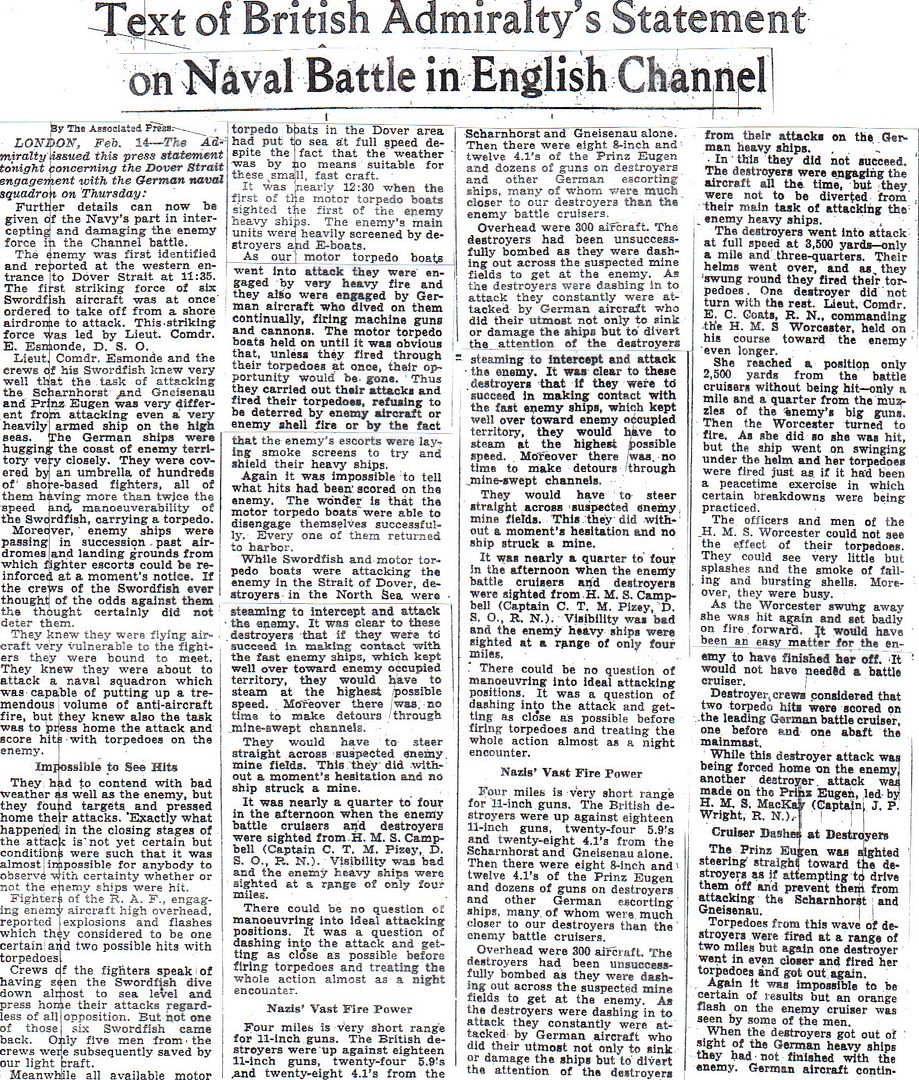











The News of the Week in Review
The Aerial Pattern of Japan’s Conquest (map) – 18
Twenty News Questions – 19
Japan’s Far-Flung Offensives Cut Deep into the Lands of the United Nations (map) – 20
10 Weeks of Pacific War Show Japan Unchecked (Baldwin) – 21
U-Boat Strategy is Hard to Meet (Hurd) – 22-23
Answers to Twenty News Questions – 23
* If Wouk’s account yesterday was accurate then the ship sending “a broadside toward Wotje Atoll” in the first photo is either Northampton or Salt Lake City. The picture is not clear enough to make out any people so we don’t know if Capt. Henry is on the bridge.
http://www.onwar.com/chrono/1942/feb42/f15feb42.htm
British surrender in Malaya
Sunday, February 15, 1942 www.onwar.com
General Percival walks to surrender under a white flagIn Malaya... The Allied defense perimeter is now a small area around the city of Singapore. Water and ammunition are in short supply. The Japanese control the water reservoir. General Percival decides to surrender and Japanese General Yamashita accepts his terms. Japanese losses in the Malayan campaign have been 10,000. British and Allied losses 138,000.
In the East Indies... Japanese reinforcements arrive in time to prevent the destruction of the oil refinery at Palembang by retreating Allied soldiers.
In Burma... Forward units of the 17th Indian Division are pulled back west of the Bilin River as the Japanese have now crossed the Salween River in force.
http://homepage.ntlworld.com/andrew.etherington/month/thismonth/15.htm
February 15th, 1942
FRANCE: During the night of the 15-16th, RAF Bomber Command dispatches ten Whitleys and six Halifaxes to attack the port area at St Nazaire; only nine aircraft bomb visually, in cloudy conditions. No aircraft are lost but three crash in England. (Jack McKillop)
MEDITERRANEAN SEA: Two merchant vessels on a convoy to Malta are sunk.
Submarine HMS P 38 torpedoes and sinks Italian merchant Ariosto (4116 BRT) off Tunisia. 138 Allied POW’s are lost. (Dave Shirlaw)
BURMA: The Indian 17th Division begins a withdrawal behind the Bilin River line, the 46th Brigade abandoning Thaton. The Japanese follow closely and try to outflank division. (Jack McKillop)
SINGAPORE: Japanese General Yamashita accepts the surrender of Singapore from General Percival.
Singapore has fallen to the Japanese army. The formal surrender took place this afternoon when Lieutenant-General Arthur Percival, the British commander, met his Japanese counterpart, Lieutenant-General Tomoyuki Yamashita - the “Tiger of Malaya.”
This staggering disaster is the greatest military defeat in British history. Tokyo is ecstatic with “victory fever” as the Japanese celebrate their triumph: their army has taken Singapore more than a month ahead of the timetable set for it by the Japanese Supreme Command.
The Allied C-in-C, General Wavell, flew to Singapore five days ago to organise attempts to stave off the impending catastrophe. There were angry words at a morning conference at Fort Canning when Wavell showed Percival a melodramatic cable from Churchill.
It read: “Battle must be fought to bitter end. Commander and senior officers should die with their troops. The honour of the British Empire is at stake.” Percival issued a provisional plan for a defensive arc around Singapore, with the northern sector to be occupied by the 11th Indian and 18th British Divisions commanded by Major-General Heath. Major-General F. K. Simmons for the southern sector.
Later that day, Percival, pressed by Wavell, ordered Bennett to mount a counter-attack. It was unsuccessful and led to further losses and confusion. The Japanese did not press their attacks - but the skies were dominated by the enemy and so was the sea. Three Japanese divisions were in invincible positions, and Percival chose not to counter-attack again.
Communications were chaotic. Water supplies were at a critical level and the lives of a million civilians in jeopardy. Despite his earlier cable, Churchill was forced to give Percival discretion to cease resistance. Tonight, 130,000 British and Imperial troops were preparing for a long ordeal as prisoners.
In Singapore City, there was almost no water, food reserves were only sufficient for a few days, and the only fuel left was in the tanks of vehicles. Lieutenant General Arthur Percival, General Officer Commanding Malaya Command tells his officers that he has permission to surrender and he sends two emissaries to the Japanese lines with a Union Jack and white flag to ask for a cease fire at 1600 hours. General YAMASHITA Tomoyuki, commander of the 25th Army, replies by note which is characteristically blunt. No terms, no discussion of terms, no cease fire, until Percival has “signed on the dotted line.” The note is a bluff; the Japanese are nearly out of supplies and ammunition but he hopes to intimidate the British into surrender. Exhausted, drenched with sweat, Percival walks to the Ford Motor Factory to meet his conqueror. Percival signs the surrender document at 1810 hours and the Japanese shelling stops at 2030 hours. The Malayan campaign lasted 70-days during which the Japanese had advanced 650 miles (1046 kilometres). The Allied defenders numbered 138,708: 67,340 Indians; 38,496 British; 18,490 Australians; and 14,382 local volunteer troops. More than 130,000 troops become POWs. (Jack McKillop)
NETHERLANDS EAST INDIES: On Sumatra, the Japanese invasion fleet enters the mouth of the Musi River near Palembang, and unloads troops of the 229th Regiment despite repeated and costly attacks by aircraft from Palembang II airdrome. The troops advance to Palembang capturing the town and relieving the paratroopers that jumped yesterday. Dutch and RAF personnel withdraw from Palembang, where the demolition of refineries is only partially completed. British personnel holding landing grounds in central and north Sumatra are ordered to the west coast for withdrawal to Java. (Jack McKillop)
Late in the day, the first ship of the convoy carrying the Australian Imperial Force’s 7th Division from the Middle East arrives at Oosthaven in southern Sumatra in the fast liner SS Orcades. The 3400 troops on the ship are the 2/3 Machine Gun Battalion, the 2/2 Pioneer Battalion and supporting troops. On learning of the surrender of Palembang, Lieutenant General John Lavarack, General Officer Commanding 1st Australian Army, persuades General Sir Archibald Wavell, Commander in Chief American-British-Dutch-Australian (ABDA) Command, to allow the troops to proceed to Batavia on Java. (Jack McKillop)
Having proceeded through Gaspar Strait to the north of Banka Island and failed to contact the Japanese force (which has already reached Banka Strait), the ABDA striking force (Rear Admiral Karel Doorman, RNN) is attacked by Japanese naval land attack planes of Genzan, Mihoro, and Kanoya Kokutais (Naval Air Corps) as well as carrier-based aircraft from the carrier HIJMS Ryujo. The Australian light cruiser HMAS Hobart is straddled, while near misses damage U.S. destroyers USS Barker (DD-213) and USS Bulmer (DD-222), which will need to retire to Australia for repairs. (Jack McKillop)
Five USAAF 5th Air Force B-17 Flying Fortresses on an anti-shipping strike claim hits on a Japanese cruiser and another ship. (Jack McKillop)
Minelayer HNLMS Pro Patria scuttled by own crew at Palembang to prevent capture by the Japanese.
Destroyer HNLMS Van Ghent while taking part in the Allied sortie against the invasion convoy for Palembang. During the transfer through Stolze Strait, she was accidentally beached on the reef of Bamidjo between Banka and Billiton island in position 03.05S 107.21E. There were no casualties and the entire crew was taken off by HNLMS Banckert.
Submarine USS Seawolf departs Surabaya for her 4th war patrol. She is ordered to patrol in the Java Sea. (Dave Shirlaw)
AUSTRALIA: U.S. Army transport USAT Meigs, U.S. freighters SS Mauna Loa and SS Portmar, and Australian coaster Tulagi, escorted by heavy cruiser USS Houston (CA-30), destroyer USS Peary (DD-226) and Australian corvettes HMAS Swan and HMAS Warrego sail from Darwin, Northern Territory, for Koepang, Timor, Netherlands East Indies. The convoy is carrying the Australian 214 Pioneer Battalion and the U.S. 148th Field Artillery Regiment (75mm Gun) (Truck-Drawn) (less the 2d Battalion), to reinforce Allied troops on Timor. (The 148th is an Idaho National Guard unit inducted in September 1940.) The units are to secure Penfoie airdrome, the only staging point on Timor for flights to Java. (Jack McKillop)
COMMONWEALTH OF THE PHILIPPINES: In the II Corps area on Bataan, the Japanese attack in limited strength to ease pressure against troops withdrawing northward from the I Corps sector. The I Corps continues to make steady progress against salient in the main line of resistance. (Jack McKillop)
SOLOMON ISLANDS: On Guadalcanal, Martin Clemens, appointed as His Majesty’s Commissioner for Guadalcanal (and Coastwatcher for the Royal Australian Navy’s Islands Coastwatching Service), takes up his duties at the Aola station. Armed with a simple and easily-broken Playfair code, and a 100-pound (45 kilogram) transmitter and receiver, Clemens’ job is to report all hostile ship movements in the sound north of the island. His radio, which requires 12 to 16 men to carry when it has to be moved, can transmit 400 miles (644 kilometres) by voice and 600 miles (966 kilometres) using Morse Code. While he awaits the Japanese advance, Clemens handles tribal disputes, judges cases, and raises the Union Jack over his home every morning. (Jack McKillop)
CHRISTMAS ISLAND: This British possession is seized by the Japanese. (Mike Yared) Location of Christmas Island. (Daniel Ross)
TERRITORY OF HAWAII: Submarine USS Grayback departs Pearl Harbor for her 1st war patrol. She is ordered to patrol in the Mariana and Bonin Islands area. (Dave Shirlaw)
U.S.A.:
Destroyer USS Brownson laid down.
Minesweeper USS Engage laid down.
Seaplane tender USS Unimak laid down.
Destroyer USS Meade launched. (Dave Shirlaw)
ATLANTIC OCEAN: A Brazilian merchant ship SS Buarque (5152-ton), an old American Hog Islander, is torpedoed and sunk by German submarine U-432 30 miles (48 kilometres) southwest of Cape Henry, Virginia at 36.35N, 75.20W. One passenger dies of a heart attack; the other 84 passengers and crew survive (Jack McKillop and Keith Allen)
At 0026, the Biela, dispersed from convoy ON-62, was torpedoed and sunk by U-98 about 400 miles southwest of Cape Race. The master, 43 crewmembers and five gunners were lost.
At 0434, the Meropi was torpedoed and sunk by U-566. The ship had been in convoy ON-60 and continued alone after the dispersal off Halifax. (Dave Shirlaw)
#13 on 20 Questions:
“Everyone knows that Abe Lincoln & George Washington were born respectively on Feb 12 & Feb 22......”
I would betcha that in our era, MOST Americans dont know their birth dates, much less their birth years.
 Here is a photo of USS Salt Lake City in Pearl in 1943:
Here is a photo of USS Salt Lake City in Pearl in 1943:  While they were sister ships with consecutive hull numbers, making them almost indistinguishable, there is a difference between them this early in the war; Northampton has radar, as shown by the "bedspring" atop the tripod mast. Salt Lake City does not. Unless the censor "airbrushed" out the radar mast prior to release, which they did do from time to time, the lack of radar mast in the Times photo leads me to believe it is a photo of USS Salt Lake City.
While they were sister ships with consecutive hull numbers, making them almost indistinguishable, there is a difference between them this early in the war; Northampton has radar, as shown by the "bedspring" atop the tripod mast. Salt Lake City does not. Unless the censor "airbrushed" out the radar mast prior to release, which they did do from time to time, the lack of radar mast in the Times photo leads me to believe it is a photo of USS Salt Lake City.
Percival’s “defense” of Malaya was one of the most pathetic episodes of WW2. Wainright earned the right to stand on the deck of USS Missouri on September 2, 1945. Percival did not.
I wonder if a ship ever went into combat while the Captain was in the toilet?
"The first mass gassings of Jews at the Auschwitz, Poland, death camp begin."
"As Reich minister for armaments and war production from 1942 to 1945, Albert Speer was an extremely important man within the Third Reich.
His personal friendship with Hitler and his exceptional organizational skills propelled him from an assistant architect to a highly influential insider within the Nazi regime.
"Hitler, who fancied himself a student of architecture, became Speer's personal mentor after witnessing his flair for visual pageantry.
Speer perfected the Nazi style of public parades and Party rallies that characterized Hitler's regime.
The megalomaniac passions of the two men were realized in the design plans for Berlin and Nuremberg, where the power and durability of the Third Reich were to be etched in stone.
"Speer's managerial talents produced near-miracles for the German war machine.
As minister of armaments, Speer kept the Army supplied in spite of massive Allied bombing.
Unscrupulous in his use of slave labor, Speer is credited with prolonging the war for at least two years.
"Speer parted company with Hitler in 1945 when he refused der Führer 's order to destroy German industries.
At the Nuremberg Trials, Speer professed to accept responsibility for his actions and was sentenced to 20 years' imprisonment.
He was released in 1966.
While in prison, Speer wrote his widely read book, Inside the Third Reich.
He died in 1981."
Second, is today the first report we've seen of Japanese paratroops supporting their invasion?
Is the report accurate and how many were involved?
Were there other occasions of Japanese paratroops?
What transport planes did they use?
Third, in "The War Summarized" on page 4, I note again the use of the term "United Nations".
Did anyone notice where did this term come from, and when did it begin to be used?
I would have said the more common term was "Allies", or "Western Allies".
I never thought about the Japanese using Parachutists. This is news to me. Thanks.
BTW, with China building a huge modern Navy, will they be tempted to try what Japan did? Taiwan, Japan, South Korea and Australia need their own nukes.
It is a sad world.
His brilliant campaign and victory will do Yamashita no good. Perceived as a potential rival by Tojo [with whom he had never gotten along], Yamashita is posted to the Kwantung Army in Manchuria, where he will remain until posted to the Phillipines shortly before the U.S. invasion in 1944.
No. See Homer's p2 image from Jan 12, 1942 here: http://www.freerepublic.com/focus/f-chat/2831902/posts
Did anyone notice where did this term come from, and when did it begin to be used?
See Homer's p1 article from Jan 3, 1942 here: http://www.freerepublic.com/focus/f-chat/2828016/posts
Third, in "The War Summarized" on page 4, I note again the use of the term "United Nations". Did anyone notice where did this term come from, and when did it begin to be used?
See Homer's p1 article from Jan 3, 1942 here: http://www.freerepublic.com/focus/f-chat/2828016/posts
Yes, I’m sure you do.
Disclaimer: Opinions posted on Free Republic are those of the individual posters and do not necessarily represent the opinion of Free Republic or its management. All materials posted herein are protected by copyright law and the exemption for fair use of copyrighted works.